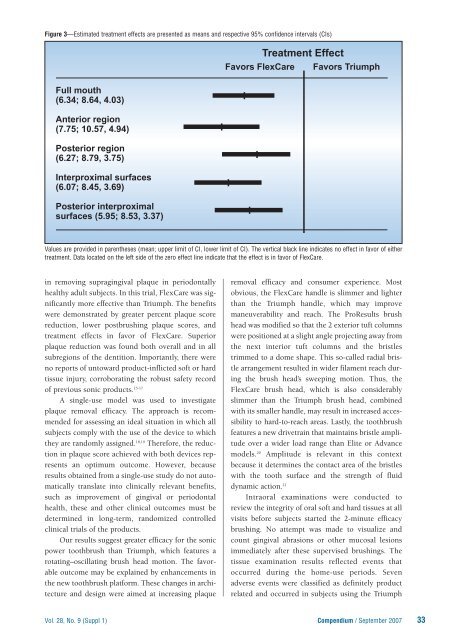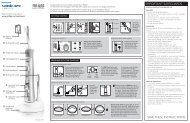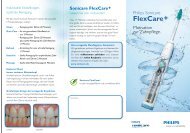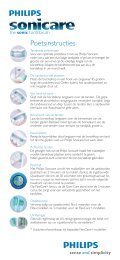Philips Sonicare FlexCare - Sonicare.com - Sonicare
Philips Sonicare FlexCare - Sonicare.com - Sonicare
Philips Sonicare FlexCare - Sonicare.com - Sonicare
You also want an ePaper? Increase the reach of your titles
YUMPU automatically turns print PDFs into web optimized ePapers that Google loves.
Figure 3—Estimated treatment effects are presented as means and respective 95% confidence intervals (CIs)<br />
Full mouth<br />
(6.34; 8.64, 4.03)<br />
Anterior region<br />
(7.75; 10.57, 4.94)<br />
Posterior region<br />
(6.27; 8.79, 3.75)<br />
Interproximal surfaces<br />
(6.07; 8.45, 3.69)<br />
Posterior interproximal<br />
surfaces (5.95; 8.53, 3.37)<br />
Treatment Effect<br />
Favors <strong>FlexCare</strong> Favors Triumph<br />
Values are provided in parentheses (mean; upper limit of CI, lower limit of CI). The vertical black line indicates no effect in favor of either<br />
treatment. Data located on the left side of the zero effect line indicate that the effect is in favor of <strong>FlexCare</strong>.<br />
in removing supragingival plaque in periodontally<br />
healthy adult subjects. In this trial, <strong>FlexCare</strong> was significantly<br />
more effective than Triumph. The benefits<br />
were demonstrated by greater percent plaque score<br />
reduction, lower postbrushing plaque scores, and<br />
treatment effects in favor of <strong>FlexCare</strong>. Superior<br />
plaque reduction was found both overall and in all<br />
subregions of the dentition. Importantly, there were<br />
no reports of untoward product-inflicted soft or hard<br />
tissue injury, corroborating the robust safety record<br />
of previous sonic products. 15-17<br />
A single-use model was used to investigate<br />
plaque removal efficacy. The approach is re<strong>com</strong>mended<br />
for assessing an ideal situation in which all<br />
subjects <strong>com</strong>ply with the use of the device to which<br />
they are randomly assigned. 18,19 Therefore, the reduction<br />
in plaque score achieved with both devices represents<br />
an optimum out<strong>com</strong>e. However, because<br />
results obtained from a single-use study do not automatically<br />
translate into clinically relevant benefits,<br />
such as improvement of gingival or periodontal<br />
health, these and other clinical out<strong>com</strong>es must be<br />
determined in long-term, randomized controlled<br />
clinical trials of the products.<br />
Our results suggest greater efficacy for the sonic<br />
power toothbrush than Triumph, which features a<br />
rotating–oscillating brush head motion. The favorable<br />
out<strong>com</strong>e may be explained by enhancements in<br />
the new toothbrush platform. These changes in architecture<br />
and design were aimed at increasing plaque<br />
removal efficacy and consumer experience. Most<br />
obvious, the <strong>FlexCare</strong> handle is slimmer and lighter<br />
than the Triumph handle, which may improve<br />
maneuverability and reach. The ProResults brush<br />
head was modified so that the 2 exterior tuft columns<br />
were positioned at a slight angle projecting away from<br />
the next interior tuft columns and the bristles<br />
trimmed to a dome shape. This so-called radial bristle<br />
arrangement resulted in wider filament reach during<br />
the brush head’s sweeping motion. Thus, the<br />
<strong>FlexCare</strong> brush head, which is also considerably<br />
slimmer than the Triumph brush head, <strong>com</strong>bined<br />
with its smaller handle, may result in increased accessibility<br />
to hard-to-reach areas. Lastly, the toothbrush<br />
features a new drivetrain that maintains bristle amplitude<br />
over a wider load range than Elite or Advance<br />
models. 20 Amplitude is relevant in this context<br />
because it determines the contact area of the bristles<br />
with the tooth surface and the strength of fluid<br />
dynamic action. 21<br />
Intraoral examinations were conducted to<br />
review the integrity of oral soft and hard tissues at all<br />
visits before subjects started the 2-minute efficacy<br />
brushing. No attempt was made to visualize and<br />
count gingival abrasions or other mucosal lesions<br />
immediately after these supervised brushings. The<br />
tissue examination results reflected events that<br />
occurred during the home-use periods. Seven<br />
adverse events were classified as definitely product<br />
related and occurred in subjects using the Triumph<br />
Vol. 28, No. 9 (Suppl 1) Compendium / September 2007<br />
33










